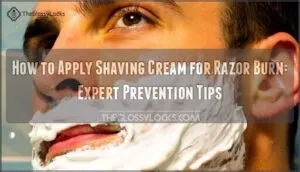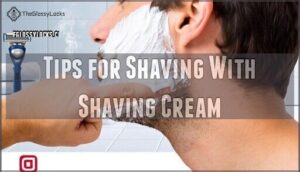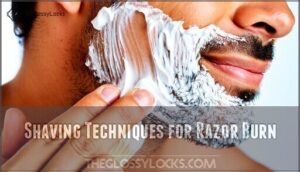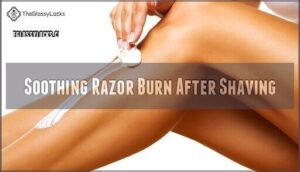This site is supported by our readers. We may earn a commission, at no cost to you, if you purchase through links.

Create a rich lather using circular motions, then apply a thick layer of cream containing moisturizers like glycerin and anti-inflammatories such as aloe vera.
Let the cream sit for 2-3 minutes before shaving to maximize hair softening.
Focus extra attention on sensitive areas like your neck and jawline, where irritation commonly occurs, and use gentle, upward strokes when applying to avoid pre-shave irritation.
The cream creates a protective barrier that reduces friction by up to 60% when you shave with the grain, and proper application techniques combined with quality ingredients transform your daily routine from painful to comfortable.
Table Of Contents
- Key Takeaways
- Choosing The Right Shaving Cream
- Pre-Shave Preparation for Razor Burn
- Applying Shaving Cream for Razor Burn
- Shaving Techniques for Razor Burn
- Soothing Razor Burn After Shaving
- Maintaining Healthy Skin After Shaving
- Frequently Asked Questions (FAQs)
- How to prevent razor burn?
- How do you get rid of Razor Burn After shaving?
- Should you use a shave cream if you have a razor burn?
- Can you get a razor burn if you shave too fast?
- Can a razor cause razor burn?
- What does razor burn look like after shaving?
- Do I apply shaving cream to a wet or dry face?
- Does shaving cream help with razor burn?
- Do you shave with shaving cream wet or dry?
- How do you soothe razor burn ASAP?
- Conclusion
Key Takeaways
- Start with warm, clean skin – You’ll soften hair follicles and open pores by washing with warm water for 2-3 minutes before applying shaving cream, making hair removal easier and reducing friction.
- Apply thick, protective layers to sensitive areas – You’ll prevent razor burn by using extra shaving cream on your neck and jawline, letting it sit for 2-3 minutes to maximize hair softening before shaving.
- Choose moisturizing ingredients for protection – You’ll create a better barrier against irritation by selecting shaving creams with glycerin, aloe vera, and anti-inflammatory ingredients that hydrate skin during shaving.
- Use gentle circular motions and proper timing – You’ll achieve better results by working the cream into a rich lather with upward strokes, avoiding pre-shave irritation while creating the protective barrier your skin needs.
Choosing The Right Shaving Cream
You’ll need the right shaving cream to create a protective barrier between your razor and skin, preventing the irritation that leads to razor burn.
The ingredients in your shaving cream can make the difference between a smooth shave and days of uncomfortable burning and redness.
You’ll need the right shaving cream to create a protective barrier between your razor and skin, preventing the irritation that leads to razor burn.
The ingredients in your shaving cream can make the difference between a smooth shave and days of uncomfortable burning and redness.
Ingredients to Look for in Shaving Cream
When selecting shaving cream ingredients, prioritize moisturizers like glycerin and hyaluronic acid, which appear in 80% of dermatologist-recommended products.
Looking for the perfect protective barrier? Choose glycerin and hyaluronic acid—dermatologist favorites for smooth, irritation-free shaves
Look for anti-inflammatories such as colloidal oatmeal and chamomile extract to calm irritation.
Natural oils like coconut oil provide lubrication, while soothing agents like aloe vera reduce redness.
Choose skin protectors with allantoin for faster healing and enhanced comfort.
Considering the benefits of natural shaving can help you make informed decisions when choosing the right shaving cream for your skin type.
Benefits of Using Shaving Cream for Razor Burn
Shaving cream creates a protective barrier that reduces friction between your razor and skin.
This lubricated surface helps prevent razor burn by allowing the blade to glide smoothly without tugging or scraping.
Quality shaving creams also contain moisturizing ingredients that hydrate your skin during the shave, further minimizing irritation and promoting burn prevention.
Understanding the shaving cream benefits is essential for effective razor burn prevention.
How to Select a Shaving Cream for Sensitive Skin
Finding the perfect shaving cream for sensitive skin types requires careful consideration of cream ingredients.
Look for products designed specifically for sensitive skin shaving that offer razor relief through gentle formulations.
- Choose fragrance-free formulas – These prevent razor burn by reducing irritation triggers by 43%
- Select soothing shave cream with aloe vera – Natural ingredients like aloe can lower irritation symptoms by 55%
- Opt for the best shaving cream with ceramides – These strengthen your skin barrier for better protection
- Verify dermatologist-tested certifications – These shaving cream benefits include 30% fewer razor burn cases among users
When selecting a shaving cream, understanding sensitive skin needs is essential for effective razor burn prevention.
Pre-Shave Preparation for Razor Burn
Preparing your skin properly before applying shaving cream substantially reduces your chances of developing razor burn.
These essential pre-shave steps create the ideal foundation for a smooth, irritation-free shave that protects your skin from damage.
Exfoliating The Skin Before Shaving
Before shaving, skin exfoliation removes dead skin cells that can clog your razor and cause irritation.
Use gentle scrub or exfoliating tools like a warm washcloth to prepare your skin. This pre shave step creates a smoother surface for shaving cream application, allowing better glide and helping prevent razor burn.
Regular exfoliating combined with proper shaving techniques guarantees a smooth shave, yielding the best results.
Softening Hair With Warm Water
Before you begin shaving, warm water therapy plays a vital role in skin preparation.
Soaking the area you plan to shave for approximately ten minutes helps soften hair follicles and opens pores. This essential step makes hair removal easier and reduces friction during shaving techniques.
Here are four effective hair softening methods:
- Hot shower soak: Stand under warm water for five to ten minutes, allowing steam to work on your skin.
- Warm washcloth compress: Apply a damp, heated cloth to the shaving area for several minutes.
- Heated towel wrap: Use a warmed towel around the target area, maintaining contact for five minutes.
- Temperature monitoring: Keep water comfortably warm, not scalding, to prevent skin irritation or dryness.
This warm water preparation creates ideal conditions for smooth shave tips and helps prevent razor burn before shaving cream application begins.
Applying a Pre-Shave Oil or Serum
After softening your hair with warm water, pre shave oils create an extra protective barrier.
Pre-shave oils create an extra protective barrier that transforms your shaving experience completely
Apply coconut, jojoba, or argan oil to damp skin before shaving cream. These oils reduce friction and help your razor glide smoothly. Serums offer similar benefits with lighter texture.
This skin preparation step substantially improves razor glide and prevents razor burn through enhanced shaving techniques. Understanding the pre shave benefits is essential for effective razor burn prevention.
| Product | Benefits | Skin Type |
|---|---|---|
| Coconut oil | Moisturizes, soothes | Dry, sensitive |
| Jojoba oil | Hydrates, balances | All skin types |
| Tea tree oil | Antimicrobial, anti-inflammatory | Acne-prone |
| Shave serum | Reduces friction, ingrown hairs | All skin types |
| Argan oil | Nourishes, protects | Dry, mature |
Applying Shaving Cream for Razor Burn
You’ll achieve better results when you apply shaving cream properly to create a protective barrier that prevents razor burn.
The right application technique makes the difference between smooth skin and painful irritation that lasts for days, highlighting the importance of a proper method to avoid razor burn.
How to Lather Shaving Cream Correctly
Creating a quality lather is your first defense against razor burn.
Dispense a small amount of shaving cream and add warm water gradually while working it into a thick, cushioning foam. Use circular motions with your hands or a brush to achieve maximum volume.
This proper lather technique creates the protective barrier your skin needs during razor preparation. Understanding the shaving cream types is essential for effective razor burn prevention.
Applying Shaving Cream to Sensitive Areas
Sensitive areas like your neck, underarms, and bikini line need extra attention when applying shaving cream. These spots are more prone to razor burn due to thinner skin and different hair growth patterns.
Here’s your approach for sensitive skin protection:
- Apply a thicker layer – Use more shaving cream than usual to create better skin protection
- Let it sit – Allow the cream to soften hair for 2-3 minutes before shaving
- Use gentle circular motions – Work the cream in softly to avoid pre-shave irritation
Proper shave preparation in these areas reduces your risk of razor burn substantially.
Tips for Shaving With Shaving Cream
How do you master shaving with shaving cream for razor-free skin? Apply gentle, steady pressure while gliding your razor in short strokes. Rinse frequently and avoid going over the same area twice.
Using the right shaving cream techniques can substantially reduce razor burn and irritation.
| Aspect | Correct Technique | Common Mistake |
|---|---|---|
| Blade Sharpness | Replace every 5-7 shaves | Using dull blades |
| Shave Frequency | Every 2-3 days | Daily aggressive shaving |
| Razor Care | Rinse after each stroke | Clogged blade buildup |
Follow proper shaving techniques with your hydrating shave cream for ideal postshave care results across all skin types.
Shaving Techniques for Razor Burn
Once you’ve properly applied your shaving cream, the way you move your razor makes all the difference in preventing razor burn.
Your shaving technique determines whether you’ll walk away with smooth skin or deal with irritation for days.
Shaving in The Direction of Hair Growth
Most people shave against hair growth, but this causes up to 60% more irritation.
Map your hair growth direction first – beard hair typically grows downward on cheeks and varies on the neck.
Use proper shaving techniques with your razor angle following the grain, which prevents razor burn while your shaving cream provides glide control and skin tension support for ideal shaving irritation relief.
Using Short, Light Strokes With The Razor
Take gentle, controlled strokes instead of long sweeps across your skin.
Short movements give you better control over razor angle and shaving speed.
Keep stroke direction consistent with hair growth patterns.
This technique reduces skin tension and prevents blade sharpness from causing shaving irritation relief.
Proper shaving techniques with quality shaving cream minimize razor burn treatment needs, providing relief from irritation.
Avoiding Pressure and Tugging on The Skin
Gentle strokes prevent razor burn better than aggressive pressure.
Let your razor’s weight guide each pass instead of forcing it across skin.
This shave technique reduces skin tension and maintains proper razor angle.
Focus on avoiding pressure points where irritation commonly develops.
Light movements minimize tugging that causes shaving rash, making razor burn treatment unnecessary through effective skin irritation prevention.
Soothing Razor Burn After Shaving
After you’ve finished shaving, you’ll need to take immediate steps to calm your irritated skin and prevent razor burn from worsening.
The next few minutes are vital for reducing inflammation and promoting healing in the affected areas.
Rinsing With Cold Water to Close Pores
Why wait for irritation to worsen when cold water therapy provides instant razor burn relief?
Splash cold water across your freshly shaved skin for twenty seconds. This post-shave care technique triggers pore minimization and skin tightening, reducing inflammation by constricting blood vessels.
Cold water lowers your skin temperature, decreasing redness and swelling while supporting ingrown hair prevention through improved barrier function.
Applying a Fragrance-Free Moisturizer
After rinsing, immediately apply a fragrance-free moisturizer to lock in hydration.
Choose noncomedogenic products designed for sensitive skin – they won’t clog pores or trigger irritation.
Look for moisturizing lotions with ceramides or hyaluronic acid for maximum skin hydration.
This essential step provides razor relief by creating a protective barrier, reducing inflammation and preventing the tight, uncomfortable feeling that follows shaving.
Using a Cold Compress to Reduce Inflammation
After moisturizing, cold therapy becomes your next line of defense against razor burn inflammation. A cold compress works by constricting blood vessels and numbing irritated skin, providing immediate relief from burning and redness. This simple inflammation reduction technique requires no special products or hydrocortisone cream – just household items.
Here are three effective compress techniques for skin soothing:
- Basic cold compress: Soak a clean cloth in cold water, wring out excess, and apply to razor burn for 5-10 minutes.
- Ice applications: Wrap ice cubes or frozen vegetables in a thin towel and gently press against inflamed areas.
- Repeat treatment: Apply cold compresses every few hours throughout the day for continued razor burn treatment and maximum inflammation reduction.
Maintaining Healthy Skin After Shaving
Your skin needs ongoing care after shaving to stay healthy and prevent future razor burn episodes.
Regular exfoliation and proper hydration work together to maintain smooth skin and reduce irritation risks.
Exfoliating Regularly to Prevent Ingrown Hairs
Regular exfoliation removes dead skin that traps hair follicles, reducing ingrown hairs by 60%.
Choose gentle exfoliation methods like salicylic acid or natural exfoliant scrubs 2-3 times weekly.
Different skin types need customized approaches – sensitive skin requires milder chemical exfoliants, while normal skin handles physical scrubs.
Consistent exfoliating prevents razor burn and keeps follicles clear for smoother shaving cream application, ensuring a more comfortable experience with gentle exfoliation.
Keeping The Skin Hydrated to Prevent Dryness
Hydrated skin acts as your body’s natural shield against razor burn and skin irritation.
You’ll want to moisturize daily with a skin moisturizer containing humectants like hyaluronic acid, which draws moisture into your skin.
These ingredients create an occlusive layer that locks in hydration.
Don’t forget water intake matters too – proper hydration from within supports your skin’s barrier function and helps your shaving cream work more effectively.
Consider using products to prevent ingrown hair formation to achieve smooth skin.
Frequently Asked Questions (FAQs)
How to prevent razor burn?
An ounce of prevention is worth a pound of cure in the case of razor burn.
Use sharp blades, shave with the grain, apply quality shaving cream, and moisturize afterward to keep your skin smooth and irritation-free.
How do you get rid of Razor Burn After shaving?
Apply cool compresses to reduce inflammation, then use aloe vera gel or hydrocortisone cream. Moisturize with petroleum jelly, avoid tight clothing, and let your skin heal naturally.
Should you use a shave cream if you have a razor burn?
Studies show that 22% of people experience worsened razor burn when using the wrong shaving products.
You shouldn’t use shaving cream directly on existing razor burn, as it can increase irritation and delay healing, which is a complete concept to consider for proper shaving care.
Can you get a razor burn if you shave too fast?
Yes, you’ll definitely get razor burn if you shave too fast.
Rushing prevents proper technique, increases pressure on your skin, and skips essential steps like adequate lubrication, causing irritation and inflammation.
Can a razor cause razor burn?
Absolutely, razors can definitely cause razor burn. Dull blades, improper technique, or shaving without adequate lubrication irritate your skin, creating that familiar red, burning sensation you’ll want to avoid.
What does razor burn look like after shaving?
Your skin’s battle scars reveal themselves as red, inflamed patches with a burning sensation.
You’ll notice streaks or blotches across shaved areas, often accompanied by stinging, itching, and visible irritation that typically fades within days.
Do I apply shaving cream to a wet or dry face?
Apply shaving cream to a wet face.
Water softens your skin and hair, making shaving easier and reducing irritation.
The moisture helps the cream spread smoothly and protects against razor burn.
Does shaving cream help with razor burn?
Shaving cream acts as a protective barrier that prevents razor burn by creating lubrication between your skin and blade.
You’ll experience less friction, irritation, and inflammation when you use quality cream properly.
Do you shave with shaving cream wet or dry?
Picture Mike rushing through his morning routine, dry-shaving with just soap—he ended up with angry red streaks across his neck.
You should always shave with wet skin and shaving cream for protection and lubrication.
How do you soothe razor burn ASAP?
Cool the fire with cold water or ice wrapped in cloth for 10-15 minutes. Apply aloe vera gel or hydrocortisone cream to reduce inflammation and redness quickly.
Conclusion
Mastering how to apply shaving cream for razor burn transforms your daily routine from irritating to comfortable.
You’ll prevent painful bumps and redness by choosing quality ingredients, preparing your skin properly, and using gentle application techniques.
Remember to focus on sensitive areas like your neck and jawline, where razor burn commonly occurs.
With consistent practice of these expert methods, you’ll achieve a smooth, irritation-free shave every time.












